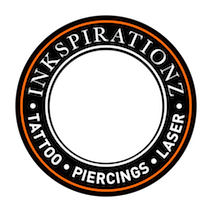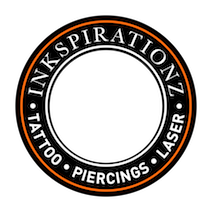Healing piercings discharge lymph, blood and blood plasma, and dead cells. The purpose in cleaning your piercing is to remove this discharge as well as any dirt or bacteria picked up during the day. The products you use on your piercing are not what make it heal—they only keep the piercing clean while your body works to heal it. Do not think of your cleaning solution as medicine, because it isn’t. Salt water and/or saline solutions should be used to irrigate your piercing, but it is the action of flushing out the wound that helps healing, not the saline itself. Likewise, soap should just be treated like soap; lather around your piercing and then rinse thoroughly.
Basic Piercing Care
New piercings should typically be cleaned twice daily (thought the frequency also depends on your skin type, your daily activities and environment, and what piercing you are trying to heal). You should continue this cleaning routine for the entire healing period. Do not over-clean your piercing. Cleaning too often with an overly harsh cleaning solution, or with too many different types of cleaning solutions, can irritate your piercing. If cleaning your piercing twice a day is suggested, don’t assume cleaning it ten times a day is better: It isn’t. You wouldn’t wash your hands three times in a row with three different types of soap, would you?
Healing piercings discharge lymph, blood and blood plasma, and dead cells. The purpose in cleaning your piercing is to remove this discharge as well as any dirt or bacteria picked up during the day. The products you use on your piercing are not what make it heal—they only keep the piercing clean while your body works to heal it. Do not think of your cleaning solution as medicine, because it isn’t. Salt water and/or saline solutions should be used to irrigate your piercing, but it is the action of flushing out the wound that helps healing, not the saline itself. Likewise, soap should just be treated like soap; lather around your piercing and then rinse thoroughly.
Warm Sea Salt Soaks
The single best thing you can do for your piercing is to keep a regular regimen of salt water soaks. These flush out the piercing, help to draw out discharge, stimulate blood circulation, and soothe irritations. We strongly suggest soaking your piercing at least twice a day—more often if healing is difficult.
Make a soaking solution by mixing sea salt and distilled water. Use pure sea salt (non-iodized) and notPiercing Care – Sea Salt table salt, which contains extra chemicals that can irritate your piercing and dextrose (sugar) that can cause yeast infections. When buying salt, read the label: If it contains only sodium chloride (salt), or just salt and calcium (as an anti-caking agent—calcium phosphate or calcium silicate), it’s good. Do not use Epsom salts, as this is a completely different chemical compound, and make sure your salt-to-water ratio is correct: a stronger or weaker solution is not better and may actually harm your piercing. It’s usually easiest to make up the mixture by the gallon, heating it as you need it.
Ingredients
- SEA SALT
- WATER
One time use:
Sea salt - 1/4 Teaspoon
Water - 1 Cup (8oz)
To use:
Make the water as warm as you can stand it without burning yourself. (You can heat it in the microwave.) Put the solution in a glass, press the glass against your skin to form a seal, and hold it over your piercing for five minutes or until the water cools.
For piercings like nostrils, ears, nipples, and some male genital piercings the entire body part should be submerged in the solution. For genital piercings, a warm bath is also an effective soak—especially for women. (Just make sure you clean your tub with a bleach-based cleaner first.)
Sterile Saline Solution
Sterile saline solutions are a convenient, portable cleaning option. While rinsing with saline solution doesn’t promote increased blood flow to the area the way that a warm soak does, it does provide a piercing care saline sprayquick cleaning fix if you’re at work, traveling, or someplace where soaking isn’t an option. Popular brands include H2Ocean® and Steri-Wash. (The saline products
sold for contact lenses or ear and nasal irrigation sometimes contain additives that may not be suited to healing piercings. Instead, check the first aid aisle of your drugstore and look for saline specifically formulated for wound care.)
Sterile Saline Solution
Spray Bottle
To use:
Liberally spray the solution, thoroughly cleansing the piercing. Your jewellery does not need to be rotated and sterile saline solution does not need to be rinsed off. (Do not simply dip cotton balls or swabs in a saline solution and apply it to the skin; you must irrigate the piercing to clean it effectively.)
Mild Antibacterial Soap
While sea salt soaks and/or saline rinses are the preferred aftercare for most piercings, soap effectively removes the residue of dirt, skin oils, cosmetics, cigarette smoke, and natural discharge that can sometimes remain after a salt water soak or saline rinse. While some piercers recommend antibacterial soap, it has not been proven more effective than other kinds of soap; it is the action of washing that is most effective in removing bacteria, not the soap itself. Use a natural, fragrance-free and dye-free soap.piercing care soap Stay away from harsh antibacterial soaps, especially those containing triclosan (like Dial®), as they can be very irritating and become less effective over time. Lastly, be sure to use a liquid soap, because bar soaps collect dirt and bacteria that can easily be reapplied to your piercing.
Wash your hands!
Before you wash your piercing, first wash your hands. (Never touch your piercing with dirty hands. This is the easiest way to get an infection.) Lather the soap in your hands—do not apply the soap directly to the piercing—and then lather the piercing and the surrounding area. Make sure to remove any discharge on the jewelry. After thoroughly cleaning the piercing and jewelry, rinse. (This is often easiest to do in the shower.) It is not necessary to rotate the jewelry during cleaning. If you find cleaning with soap is too harsh—if the skin around the piercing is becoming dry, red, or irritated—go back to salt water soaks and/or saline rinses.
Do not use:
Rubbing Alcohol or Hydrogen Peroxide
These are both too harsh for long-term use. Alcohol irritates and dries out your skin, and hydrogen peroxide destroys healthy skin surrounding the piercing and can actually slow healing. Commercial witch hazel solutions made with alcohol should also be avoided.
DO NOT USE Antibiotic Ointments
These include Neosporin®, bacitracin, or triple antibiotic ointments. These are not meant to be used for more than two weeks—making them ineffective for healing piercings. They also contain petroleum jelly, which keeps oxygen away from the piercing and creates the perfect warm, moist environment for bacteria to grow; this also keeps soap and other cleaning solutions from properly cleaning the piercing. Ointments are made for cuts and scrapes, not long-term healing.
DO NOT USE Bactine®, pierced ear care solutions, or other products containing benzalkonium chloride (BZK) or benzethonium chloride (BZT)
These can be irritating. Bactine® and similar products contain lidocaine, which can irritate your piercing even more. These products also have a very short shelf life once opened. If you have a leftover bottle of one of these in your medicine cabinet DO NOT USE IT. Throw it out.
DO NOT USE Betadine® (povidone-iodine) or Hibiclens®
These are far too harsh for daily cleaning. Hibiclens® can cause permanent damage if you get it in your eyes or ears. Betadine® will discolor gold jewelry.

